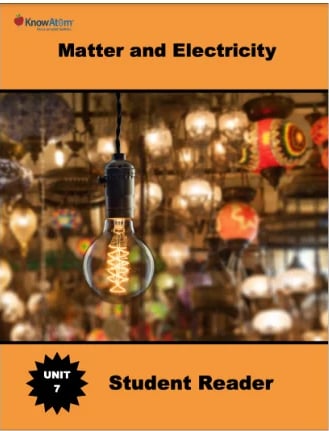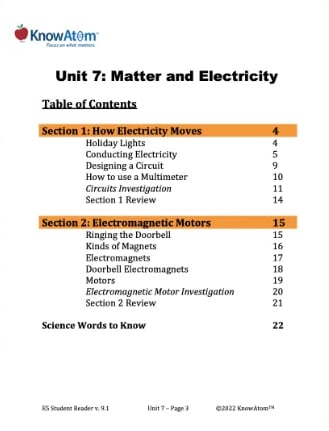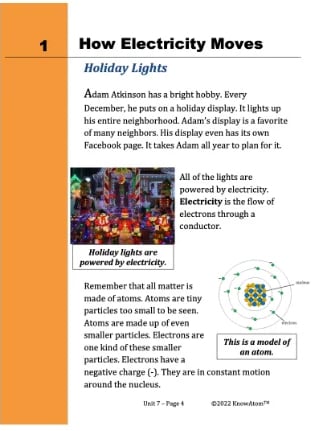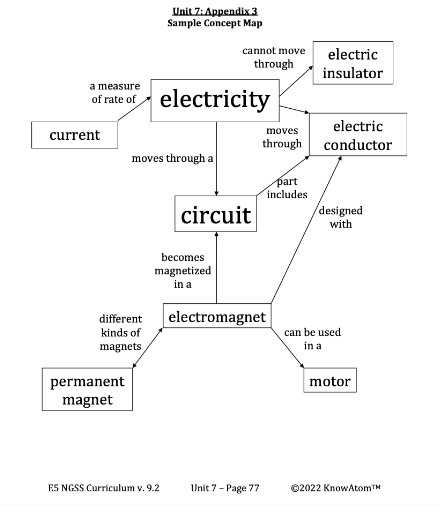Science background gives teachers more in-depth information about the phenomena students explore in this unit on matter and electricity. Here is an excerpt of the science background information for this lesson.
Understanding the phenomena of electricity begins with the basic particles of matter: atoms. Remember that all matter is made of atoms, which are the smallest pieces of matter that have the properties of an element. Atoms are so tiny that we cannot see them.
Atoms themselves are made up of smaller particles, called protons, neutrons, and electrons. Electrons have a negative charge (-) and are attracted to positively charged protons (+).
The force that holds protons and electrons together in an atom is called electromagnetic force. It occurs whenever particles are charged, causing them to either attract or repel one another. Particles with an opposite charge attract one another, while particles with the same charge repel one another. Electrons are kept in orbit in their shells because the positive charge of the protons in the nucleus attracts the negatively charged electrons.
Protons repel each other in the nucleus because they all have a positive charge, but they stay together because of another force, called the strong force. The strong force counters electromagnetic force because it is the strongest attractive force, 137 times more powerful than electromagnetic force. However, it only exerts a force over very short distances, and so it does not exert a force over electrons.
Electrons that are in shells closest to the nucleus are tightly bound to the positive protons because of electromagnetic force. Just like the strong force, electromagnetic force weakens with distance, so electrons in the outermost shell are much more loosely bound. When a force is applied to certain kinds of matter, those farther electrons can be pushed from one atom to another.
Electrons can move more easily through some kinds of materials than others. Materials that allow electrons to pass through are called electrical conductors. Metals are common conductors. Silver, copper, bronze, and aluminum are all metals and good conductors.
Some materials don’t allow electrons to pass through as easily. These materials are called electrical insulators. Glass, rubber, plastic, and ceramic are all good insulators.
When electrons move through a conductor, it produces electricity. There are two kinds of electricity: static and current. Static electricity is a type of electricity that results from the buildup of electric charge on the surface of an object.
Current electricity is a type of electricity in which electrons move through a circuit. A circuit is the circular path electrons travel from a negative charge to a positive charge. Electronic devices use electric current by directing it through the wires of a circuit. The electrons are first pushed through a wire by a power source, such as a battery or electrical generator. From there, the electric current travels through the wire until it reaches an object that can do work.
For example, a passing electric current can light a light bulb, warm a toaster, or turn on a computer. This is because moving electrons carry with them electrical energy that is converted to another form of energy, such as light energy or heat. Energy is conserved, which means the same amount of energy that is carried by the electrons is converted to do work. The electrical current then travels down a second wire back to the power source. The entire circuit forms a circular loop.
A circuit must be complete and unbroken to function properly. If the wire is broken, the circuit is open and the electricity stops moving. The air between the broken wires will not conduct or transport the electrons. The wire must be repaired to close the circuit and restart the electron flow. There are four main parts of a circuit.
- All circuits have an energy source. Many circuits use a battery, which has stored chemical energy that converts to electrical energy. This energy provides the push that makes the electrons in the conductive material move through the circuit from the negative end of the battery through the circuit to the positive end. They move because the negatively charged electrons are attracted to the positive side of the battery.
- Wires create a path of conducting material for electrons to travel. As the electrons move, energy is carried from the battery through the conductors inside the wires.
- The wires in a circuit are attached to an object that can convert electrical energy to do work (any change in position, speed, or state of matter due to force). For example, a light bulb is an object that does work. When electrons reach the light bulb in a circuit, electrical energy is changed into light energy. The electrons then continue on their path, returning to the opposite side of the battery. All circuits must include something that can do work. Without this part, the electricity will cause danger by overheating the circuit. This is called a “short circuit.
- The switch opens and closes the circuit. Electrons flow when a circuit is closed. This is “on.” A closed circuit can be used to charge a cell phone or turn on a light. Electrons cannot flow when a circuit is open. This is “off.” No work can be done in an open circuit.










